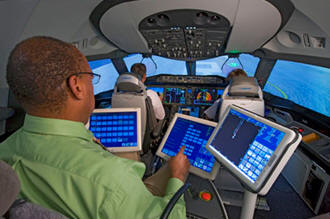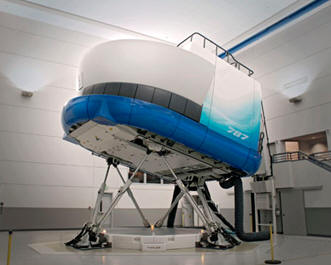|
|||||||||||
|
|
|
|||
|
By Jim Douglas |
||||
 |
August 29, 2010 - Boeing Training and Flight Services has started 787 Dreamliner flight certification training following the provisional approval from the U.S. Federal Aviation Administration (FAA) for Boeing's Seattle-based 787 flight training devices. As part of flight training, pilots train on a 787 flat panel training device and a 787 full-flight simulator. Both devices are manufactured by Thales. "The innovations of the 787 have inspired us to develop the most effective training curriculum based on our customers' training needs matched with efficient delivery and modern simulation tools," said Sherry Carbary, vice president, Flight Services, Boeing Commercial Airplanes. "With the FAA's approval on our flight training devices, we are embarking on an exciting journey toward delivering qualified and competent crews." The provisional designation will be removed once the airplane is fully certified. Local FAA offices will approve training courses customized for individual operators and these may be based on provisional approvals prior to certification of the airplane. "We're pleased with the progress we are making in ensuring our support products and services are ready for our customers," said Mike Fleming, 787 director of Services and Support, Boeing Commercial Airplanes. "This is an exciting time for our customers and an important achievement for the entire Boeing team as we move toward delivery of the first 787."
There are
currently eight training suites at five Boeing Training & Flight
Services locations around the world in |
|||
 |
||||
|
|
||||
|
Originally
scheduled to enter service in May 2008, the aircraft's maiden flight
took place on December 15, 2009 in the The Boeing 787 Dreamliner will be a long range, mid-sized, wide-body, twin-engine jet airliner. It will seat 210 to 330 passengers, depending on variant. Boeing states that it is the company's most fuel-efficient airliner and the world's first major airliner to use composite materials for most of its construction. |
||||
|
The 787 features lighter weight construction. Its materials (by weight) are: 50% composite, 20% aluminum, 15% titanium, 10% steel, 5% other. The aircraft will be 80% composite by volume. Each 787 will contain approximately 35 short tons of carbon fiber reinforced plastic, made with 23 tons of carbon fiber. Aluminum is used on wing and tail leading edges, titanium used mainly on engines and fasteners, with steel used in various places. Carbon fiber composites have a higher strength to weight ratio than traditional aircraft materials, and will help make the 787 a lighter aircraft. Composites are used on fuselage, wings, tail, doors, and interior. Boeing had built and tested the first commercial aircraft composite section while examining the Sonic Cruiser concept nearly five years before, the Bell Boeing V-22 Osprey military transport uses over 50% composites, and the C-17 has over 16,000 LBS of structural composites. On January 28, 2005, the aircraft's initial designation 7E7 was changed to 787. Early released concept images depicted a radical design with highly curved surfaces. On April 26, 2005, a year after the launch of the program, the final and more conventional external 787 design was set. The first 787 was unveiled in a roll-out ceremony on July 8, 2007 at Boeing's Everett assembly factory, by which time it had become the fastest-selling wide-body airliner in history with 677 orders.[6] By April 2010, 866 Boeing 787s had been ordered by 56 customers. As of 2010, launch customer All Nippon Airways has the largest number of 787s on order. Boeing said on Friday that it now expects delivery of the first 787 in the middle of the first quarter 2011. The delivery date revision follows an assessment of the availability of an engine needed for the final phases of flight test this fall. While Boeing works closely with Rolls-Royce to expedite engine availability, flight testing across the test fleet continues as planned. Boeing said last month that the cumulative impact of a series of issues, including supplier workmanship issues related to the horizontal stabilizer and instrumentation delays, could push first delivery of the 787 a few weeks into 2011. The delay in engine availability has extended that estimate to mid-first quarter 2011. |
|
|
| Other News Stories |
| ?AvStop
Online Magazine
Contact
Us
Return To News
|
|


